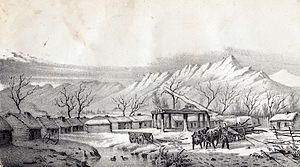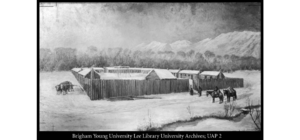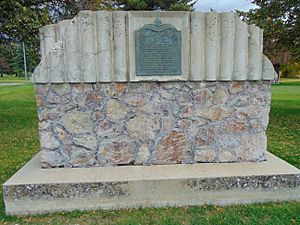Fort Utah facts for kids

Fort Utah, also known as Fort Provo, was the very first settlement in what is now Provo, Utah, United States. It was built on March 12, 1849. About 150 people, including 30 families led by John S. Higbee, came from Salt Lake City to start this new community. They were sent by President Brigham Young.
The settlers built several log houses. These homes were protected by a strong wooden fence, called a palisade, which was about 14 feet (4.3 meters) tall. The fort was quite large, measuring about 330 by 660 feet (100 by 200 meters). It had gates on the east and west sides, and even a special platform for a cannon. At first, the fort was located west of the town. However, in April 1850, it was moved to a place called Sowiette Park.
Conflict at Fort Utah
In late 1849, there were growing problems between the Ute Indians and the settlers from the Church of Jesus Christ of Latter-day Saints in Utah Valley. These problems started after a settler caused the death of a Ute man known as Old Bishop. The settler claimed Old Bishop had stolen his shirt. The settler and two others then hid the body in the Provo River.
The settlers at Fort Utah also reported other difficulties with the Utes. These included Utes firing weapons near settlers and taking their farm animals and crops. Brigham Young advised the settlers to be patient. He told them to "stockade your fort, to attend to your own affairs and let the Indians take care of theirs."
However, the problems at Fort Utah continued to grow. The Utes asked the settlers to hand over those involved in Old Bishop's death. The settlers refused to do this or to pay for his death. In the winter of 1849–1850, a sickness, measles, spread from the settlers to the Ute camps. This caused many Ute people to become ill and die, which made the tensions even worse.
On January 31, 1850, a leader from Fort Utah reported to Church leaders in Salt Lake City that the Utes were becoming more aggressive. They said the Utes planned to hunt the settlers' cattle and gather other Native American groups to fight them. Because of this, Brigham Young allowed a military action against the Utes.
On February 8, 1850, a group of soldiers from Salt Lake surrounded about seventy Ute people at Big Elk. After two days of fighting, the Utes surrendered. Many Ute men died during this conflict, and Ute women and children were taken to Salt Lake City. A series of battles in February 1850 led to the deaths of many Utes and one settler. These events were a part of what later became known as the Walker War.
Remembering Fort Utah
On August 30, 1937, a special monument was put up to remember Fort Utah. People at the time believed this was the exact spot where the fort stood in 1849. The monument was built by the Daughters of Utah Pioneers with help from the Sons of Utah Pioneers. It had a concrete base and a middle section made of local stone. The top was shaped to look like the fort's architecture. A metal plaque on the monument shared the fort's history.
Years later, Provo City bought the land around the monument. With the help of the Utah Lake Lions Club, they started to create a public space called "Fort Utah Park."
In the late 1990s, a group studied the original 1849 fort for Provo's 150th anniversary. They found that the 1937 monument and a 1972 fort replica were not on the actual site of the 1849 fort. Instead, they discovered the fort was near where Interstate 15 crosses the Provo River. It seemed the freeway or a nearby mobile home park was built right over the original spot.
So, in 1999, the Provo Sesquicentennial Committee put up a new monument. This one is just east of Interstate 15, along the Provo River Parkway Trail. This new monument is closer to where the 1849 fort actually stood. The site of the 1850 fort, after it was moved, is located at Provo's North Park, which used to be called Sowiette Park.



